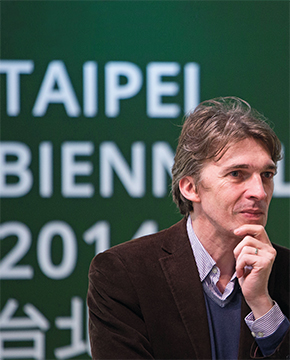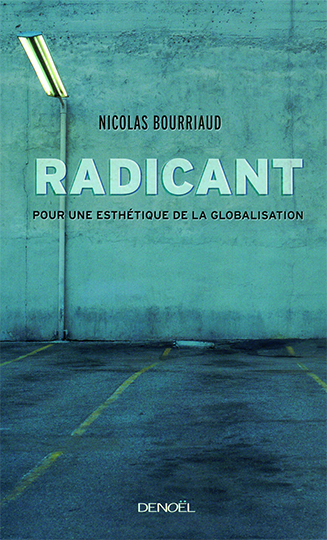NICOLAS BOURRIAUD
| September 5, 2014 | Post In LEAP 28

In the 1990s, Nicolas Bourriaud became one of the most influential authors of contemporary art criticism thanks to his work Relational Aesthetics . From 1999 to 2006, he served as co-director of Palais de Tokyo, the Paris contemporary art space he co-founded with Jérôme Sans. Bourriaud has a wealth of experience in curating international art exhibitions, having worked on the 2005 and 2007 Moscow Biennial (as co-curator), 2005 Lyon Biennale of Contemporary Art (as co-curator), the fourth Tate Triennial in 2009, and the 2011 Athens Biennale, among others. Now, he is the curator of the 2014 Taipei Biennial, due to open on September 12, 2014.
LEAP Is the exhibition format of the biennial suited to the concept of the radicant you discuss in your book Radicant: Pour une esthétique de la globalisation?
Nicolas Bourriaud Yes. A biennial is both an exhibition and a project rooted in a specific cultural context. While respecting certain local norms and rules, the curator also delivers information from an international perspective. The curatorial process behind the organization of a biennial provides an opportunity for mutual collaboration between the exhibition and the local conditions of the host city or country, and artists with local cultural backgrounds bring a rich layer of significance to the event. A radicant is a plant that takes root in different places as it grows, like ivy, for example. I think of myself as belonging to this genus; my own roots are spread out everywhere, and because of this I am better able to understand the Other and adapt quickly to new environments.
LEAP Recently, in a lecture you gave in Taipei, you discussed the importance of avoiding turning an exhibition into a “demonstration of one arbitrary concept or idea.” How can we steer away from this, such that an exhibition goes beyond a solely illustrative relationship between theme and artwork?
NB Indeed, generally speaking, when an exhibition attempts to expound upon a pre-existing theme, it can go badly. If the function of the artwork is merely to illustrate a theme, then the full power held in those works is truncated. So for me, an exhibition isn’t a documentary—it isn’t an account searching for its own pre-established identity through the experience of some encounter. My exhibitions more closely resemble docufiction, reflecting facets of the reality of contemporary art coming together through a certain image or central hypothesis. In this way, the viewer can choose to follow the exhibition text, to create his or her own interpretation, to listen to the thoughts of the curator, or to place attention entirely on the works themselves. Just as in an opera, text and music are of equal status.

globalization”, French edition
LEAP The title of the Ninth Taipei Biennial is “The Great Acceleration: Art in the Anthropocene.” What are your thoughts on acceleration? How is it manifested in the exhibition?
NB Acceleration is a failure of human scale. It embodies our powerlessness in the face of the information economy, where every decision is handled at the speed of light and executed by computing models (in the United States, high-frequency trading already makes up 75% of all equity trading volume). The anthropocene is not only a geological concept but also a reference to an era like this one, in which humankind has already become a victim of its own infrastructure. We can see, amidst an emerging hierarchy of individuals or citizens and their disposable objects, a kind of unprecedented political alliance: animals, plants, minerals, and the atmosphere are attacked by an industrial-technological complex that has broken with civil society. In this exhibition of acceleration, I have brought together artists employing a range of approaches to reflect upon this new world order.
LEAP In The Radicant, you also discuss the final stages of modernism, marked by a committed search for root causes. You engage with contemporary artists’ new nomadic working styles and philosophies as they confront a wave of globalization, exploring concepts like transplantation and translation. Does this biennial continue your study of the non-anthropocentric and your interest in the radicant?
NB Each of my books inspires the content of the next, and my exhibitions are similar. For instance, I recently realized that the exhibition I curated in London, “Altermodern,” actually contained the original intention and curiosity that would later give rise to “The Great Acceleration.” Though the explicit idea came later, the theme was already present in many of the works shown in London, just without me recognizing it. For me, personally, a continuous thread through curatorial practice comes from an ongoing exploration of the evolving conditions of human existence, an inquiry into how these changes function in works of art, and an examination of the role they play in artists’ organization and production of their work. But my intention is not based in the creed of anti-anthropocentrism; I retain a critical stance toward the idea.
LEAP What is your view on the position and influence of speculative realism and animism in contemporary art, these recent philosophical and aesthetic movements absorbed by the question of things? Can current artistic practices be seen as concrete responses to these intellectual trends?
NB As I just mentioned, I maintain a critical attitude with regard to what is called speculative realism. This exhibition does not exist for the sake of jellyfish or trees; art is an activity that belongs to the realm of human relationships. Conversely, this new concern with objects lends itself to a very different perspective on our ecosystem—extending the human field of vision to encompass an ecological awareness of objects, of other life forms, and of our surrounding environment. From this angle, speculative realism has the potential to rejuvenate the way we see things. For this exhibition, what interests me is the collision between practices influenced by an expanded approach to observation, and by the relational concept of aesthetics I developed in the 1990s. I juxtapose the two, looking at them together as a way to generate questions. What is the true composition of the network of human interpersonal relationships? Might art be able to bridge these relationships? As for animism—a trend that has incited much discussion in the past two years—in my view it closely approaches anti-anthropocentrism in that it emphasizes the endowment of objects or animals with souls, assigning them human characteristics. It seems as though today’s artists are unsatisfied with this phenomenon, and are attempting to move out in different directions: from objects to organisms, minerals to products of industry, the world of plants to the world of the digital, humankind to animals …
LEAP In your notes on the Biennial, you write, “Relational art is often blamed for being overly inclined towards ‘anthropocentrism,’ even humanism … in the eyes of some, relational aesthetics is behind the times and difficult to stomach.” Your book Relational Aesthetics was published in the 1990s, coinciding with the end of the Cold War and the rise of the internet. Do changes in the present social context bring about an intellectual adjustment for you, in terms of your original aesthetic proposition?
NB The idea behind this exhibition comes from an essay I read that suggested that today the number of task-performing bots on the internet is greater than the number of humans on the planet. Twenty-five years after the birth of the internet, humankind has gotten lost, so the original principles of relational aesthetics must indeed be revisited. What role do these principles play now? Like the structuralism of the 1950s and 1960s, the birth of speculative realism has reconfigured humankind’s status as subject. In those days we talked about structure; now we talk about substance. But if we observe the world from the perspective of substances, as advocates of speculative realism would prefer—that is, if we abandon our understanding of the world in terms of a series of relationships—then existence overrides knowledge and substances themselves override the awareness we derive from looking at and thinking about them. I see that, if we take the materialist framework as our starting point, no hierarchical distinction exists a priori between material and non-material entities. But, from a political perspective, with the capitalist system reifying and converting organic systems into products as never before, it is extremely important at this juncture that we give human beings their own special rights.
LEAP Since 2000, artistic practices surrounding relational aesthetics have been accorded many different names, including participatory art, socially engaged art, and so on. These titles are used to describe a kind of participatory phenomenon that produces relationships in artistic creation. How do you determine the subtle differences between all of them?
NB Participatory art was born in the 1960s alongside the practices of artists like Allan Kaprow, those behind the Fluxus movement, and then later Gordon Matta- Clark. The main objective of participatory art is to broaden the field of artistic practice, as opposed to proposing ways to consider the form and nature of interpersonal relations. Socially engaged art is not a recent mode of practice either; Beuys’ work proves this point early on. But the newer phenomenon that we see emerging in the 1990s is a group of artists who choose interaction as a subject of their creative work. Outside of this, they do occasionally draw from elements of their interactive antecedents. Both participatory art and socially engaged art are subsets as well as predecessors of the relational art of the 1990s.
LEAP What is the relationship between different forms of writing and the exhibition you ultimately present to your audiences? Between writing and curating, which kind of work is more fundamental for you?
NB I am trying to prevent the art system from placing writing and curatorial work into a stratified framework. Neither is subordinate to or dominant over the other. I’ve also been consistently engaged in an investigation of ways in which the two might be symbiotic: a discourse can produce an exhibition or several; an exhibition can bring me back into writing. For instance, I was writing The Radicant at the exact same time that I was planning “Altermodern” at Tate Modern. The processes of these two activities echo and enrich one another. When I want to pose a new question, I’ll do an exhibition; when I’ve uncovered some answers, I’ll put it into writing. An exhibition is a medium for open questions: it is a gathering place where voices come together. Writing is a more solitary, reflective process. My whole career is an ongoing back-and-forth between these two states.

